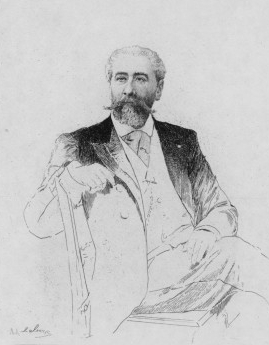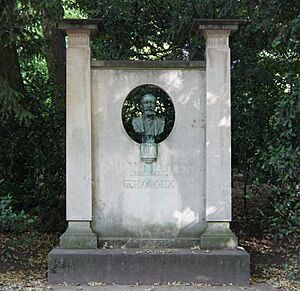José-Maria de Heredia facts for kids
Quick facts for kids
José-Maria de Heredia
|
|
|---|---|

José-Maria de Heredia as drawn by Adolphe Lalauze
|
|
| Born | 22 November 1842 Fortuna Cafeyere, Cuba |
| Died | 3 October 1905 (aged 62) Seine-et-Oise, France |
| Occupation | Poet, librarian |
| Language | French |
| Alma mater | École Nationale des Chartes |
| Literary movement | Parnassianism |
| Children | Marie de Régnier |
José-Maria de Heredia (born November 22, 1842 – died October 3, 1905) was a famous French poet. He was born in Cuba but spent most of his life in France. Heredia was part of a group of poets called the Parnassians. In 1894, he became a member of the Académie française, which is a very important group of French writers and thinkers.
Contents
Who Was José-Maria de Heredia?
Early Life and Education
José-Maria de Heredia was born in a place called Fortuna Cafeyere, near Santiago de Cuba. His father was from Santo Domingo, and his mother was French. When he was eight years old, he moved from the West Indies to France. He went back to Havana, Cuba, when he was seventeen. But soon after, he made France his permanent home.
He received a good education from priests in Senlis, France. After his visit to Havana, he studied at the Ecole des Chartes in Paris. This school taught him about old documents and history.
Becoming a Parnassian Poet
In the late 1860s, Heredia joined a group of poets. These poets included François Edouard Joachim Coppée, René François Armand Sully-Prudhomme, and Paul Verlaine. They were inspired by Charles Leconte de Lisle. This group became known as the "Parnassiens."
The Parnassian poets believed that the form of a poem was very important. They focused on making their poems perfect in structure and style. They tried not to show too much personal feeling in their work. Heredia once said that "True poetry dwells in nature and in humanity, which are eternal." This meant he believed poetry should focus on timeless ideas, not just a person's feelings.
His Famous Works
Heredia did not write a lot of poems, and he published even fewer. However, his sonnets (a type of poem with 14 lines) were shared around as handwritten copies. This made him famous even before they were officially published. In 1893, his sonnets and a few longer poems were collected into a book called Les Trophées. An artist named Ernest Jean-Marie Millard de Bois Durand created beautiful watercolor pictures for the original book.
In 1893, Heredia became a French citizen. The next year, on February 22, 1894, he was chosen to join the Académie française. This was a big honor, especially since he had published only a small amount of work. His main works included:
- Les Trophées (1893) – his collection of sonnets.
- A translation of Diaz del Castillo's History of the Conquest of New Spain (1878–1881).
- A translation of the life of the nun Alferez (1894).
Even though he wrote little, his sonnets are considered some of the most skillful in modern literature.
Later Life and Legacy
In 1901, José-Maria de Heredia became the librarian at the Bibliothèque de l'Arsenal in Paris. He passed away on October 3, 1905, in Seine-et-Oise, France. Before he died, he finished working on a special edition of André Chénier's writings.
See also
 In Spanish: José María de Heredia para niños
In Spanish: José María de Heredia para niños
- José María Heredia y Campuzano Cuban poet
- Severiano de Heredia Cuban-born politician naturalized as French


